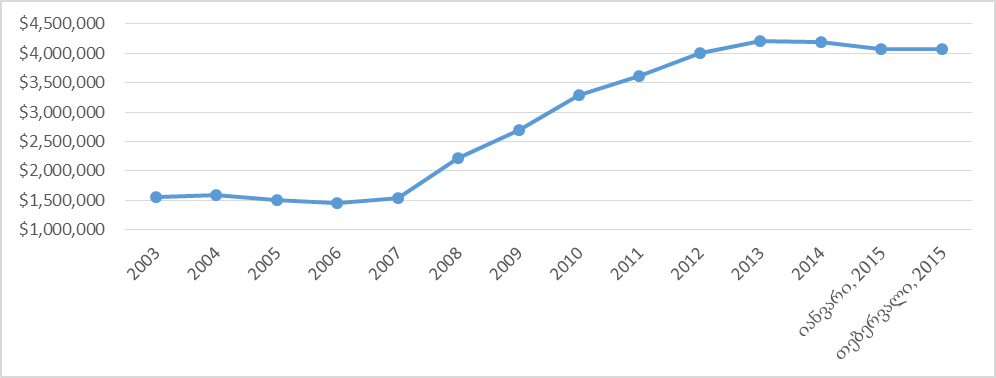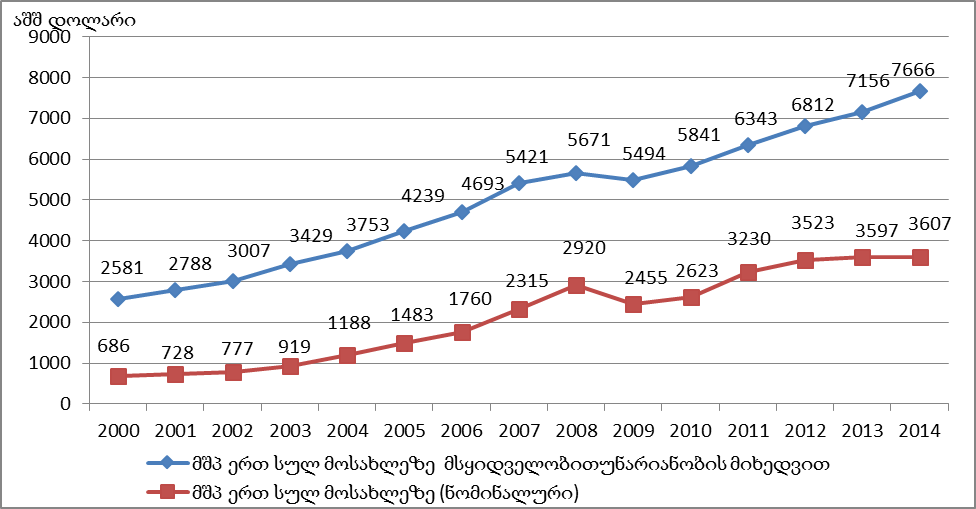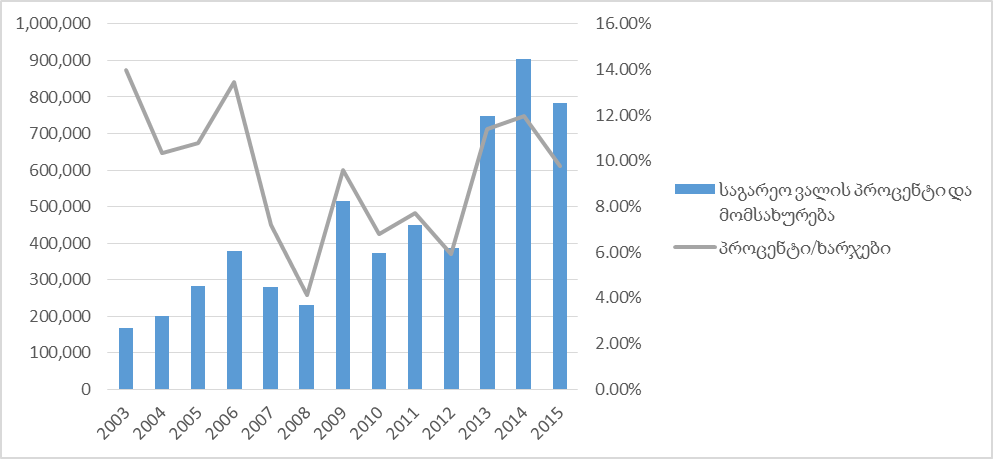On 27 February 2015, on air on Imedi TV, members of the Parliamentary Majority, Giga Bukia, and the Parliamentary Minority, Zurab Japaridze, discussed the issue of Georgia’s foreign debt. According to Mr Bukia, the Government of Georgia has started to pay its foreign debt since 2013 and this requires increased spending from the budget as compared to what had been spent before. Mr Bukia also emphasised that the budget was increased six-fold under the previous government only at the expense of the foreign debt. Zurab Japaridze replied that the nominal foreign debt did indeed increase in absolute numbers but a more significant indicator is calculating the foreign debt to the GDP ratio (%). Mr Japaridze also mentioned that at the beginning of the United National Movement’s rule, the debt to the GDP ratio was more than 45% whilst that number stood at 32% at the end of 2012.
FactCheck took interest in the accuracy of the MPs’ statements.
Table 1 illustrates the volume of Georgia’s total foreign debt service in the period of 2004-2014. The table also includes Georgia’s budget revenues, expenditures and the total debt service to the total government expenditures ratio.
Table 1: Foreign Debt Service, Budget Revenues and Expenditures (GEL thousand)
|
Foreign Debt Interest and Principal Sum |
Budget Revenues |
Budget Expenditures |
Budget Revenues minus Debt |
Debt/Expenditure |
|
|
2004 |
199,449 |
1,655,030 |
1,926,355 |
1,455,581 |
10.35% |
|
2005 |
282,040 |
2,607,867 |
2,618,557 |
2,325,827 |
10.77% |
|
2006 |
378,321 |
3,139,227 |
2,809,428 |
2,760,906 |
13.47% |
|
2007 |
278,961 |
4,469,123 |
3,866,236 |
4,190,162 |
7.22% |
|
2008 |
230,315 |
5,517,690 |
5,554,685 |
5,287,375 |
4.15% |
|
2009 |
516,172 |
4,916,958 |
5,367,210 |
4,400,785 |
9.62% |
|
2010 |
371,987 |
5,421,474 |
5,466,467 |
5,049,487 |
6.80% |
|
2011 |
449,078 |
6,442,308 |
5,823,850 |
5,993,230 |
7.71% |
|
2012 |
387,704 |
7,115,329 |
6,566,316 |
6,727,625 |
5.90% |
|
2013 |
746,908 |
6,839,494 |
6,545,615 |
6,092,586 |
11.41% |
|
2014 |
903,128 |
7,319,000 |
7,539,613 |
6,415,872 |
11.98% |
|
2015 |
783,329 |
8,090,000 |
8,005,443 |
7,306,671 |
9.78% |
Georgia’s budget revenues were GEL 1.3 billion in 2003 whilst this amount rose to GEL 7.1 billion in 2012. In the period of 2004-2012 Georgia’s budget revenues increased 4.3 times. Deducting the debt service (the principal amount plus interest) from the expenditures would mean that the budget increased 4.6 times in the same period.
The Government of Georgia’s foreign debt rose 2.6 times in absolute numbers (nominal) in the years of 2003-2012. In 2004-2006 the volume of debt decreased but in the aftermath of the Russian-Georgian war and as a result of the world financial crisis, the government had to increase the foreign debt. Georgia’s foreign debt rose by 44.5% in 2008, by 21% in 2009 and by 21.9% in 2010. In the period of 2011-2012 the average foreign debt growth rate equalled 10%. In the period of 2013-2014, Georgia’s foreign debt grew by 2.5%.
Graph 1: Government of Georgia Foreign Debt, 2003-2015
Source: Ministry of Finance of Georgia
The debt to the GDP ratio is more important as compared to a country’s debt in absolute numbers. The former indicates the ratio between a country’s wealth and its obligations and illustrates the degree to which it is capable of bearing the burden of debt. If a country’s debt constitutes more than 100% of its GDP, this means that it has bigger obligations than its production. It must be noted that in the period of 2003-2014, the debt to the GDP ratio decreased in Georgia. It was almost 45% in 2003 whilst in 2012 it dropped to 27.6%. The total government debt to the GDP ratio was 63.2% in 2003 whilst in 2012 it constituted 34.9%.
Graph 2: Foreign Debt to the Nominal GDP Ratio
Source: Ministry of Finance of Georgia
The Government of Georgia did not start to pay its foreign debt in 2013 as claimed by Giga Bukia. The graph below does illustrate that the country did pay its foreign debt in the period of 2003-2012. The MP is right to state that the total foreign debt service has increased in absolute numbers since 2012. However, the debt service to the total (budgetary) expenditures ratio has only marginally increased; for instance, this number was higher in 2006 as compared to 2013-2014.
Graph 3: Interest Payments and their Ratio to Budget Expenditures (2003-2015)
Source: Ministry of Finance of Georgia
Conclusion
In the period of 2004-2007, the Government of Georgia’s foreign debt decreased both in absolute numbers and to the GDP ratio. However, in the aftermath of the Russian-Georgian war in 2008 and due to the world financial crisis, the foreign debt increased in 2008-2010.
Giga Bukia’s statement that Georgia’s budget increased mostly at the expense of the growth of the foreign debt in 2003-2012 is incorrect. Until 2008, the foreign debt was decreasing whilst the state budget grew considerably. Additionally, if we deduct the debt interest and the principal sum service payments from budget expenditures, we shall see that the budget grew 4.6 times in the period of 2004-2012.
Zurab Japaridze’s statement that the debt service has been increased but only marginally for the last two years is correct. Mr Japaridze’s other statement that the debt to the GDP ratio was significantly reduced in 2012 as compared to 2003 is also correct.
Therefore, FactCheck concludes that Zurab Japaridze’s statement is TRUE whilst Giga Bukia’s statement is MOSTLY FALSE.











